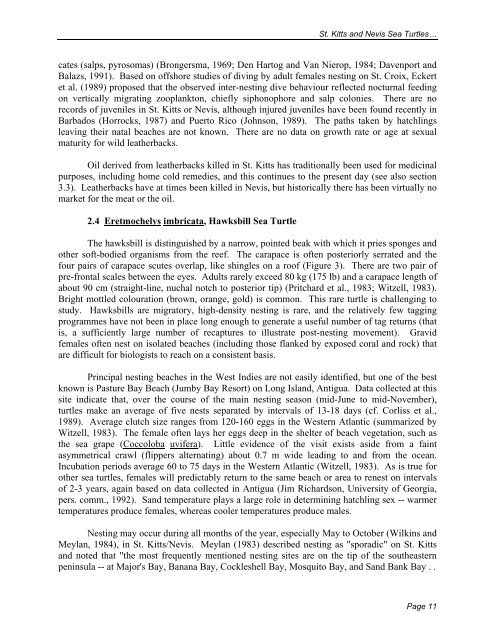Sea Turtle Recovery Action Plan for St. Kitts and Nevis - WIDECAST
Sea Turtle Recovery Action Plan for St. Kitts and Nevis - WIDECAST
Sea Turtle Recovery Action Plan for St. Kitts and Nevis - WIDECAST
You also want an ePaper? Increase the reach of your titles
YUMPU automatically turns print PDFs into web optimized ePapers that Google loves.
<strong>St</strong>. <strong>Kitts</strong> <strong>and</strong> <strong>Nevis</strong> <strong>Sea</strong> <strong>Turtle</strong>s…<br />
cates (salps, pyrosomas) (Brongersma, 1969; Den Hartog <strong>and</strong> Van Nierop, 1984; Davenport <strong>and</strong><br />
Balazs, 1991). Based on offshore studies of diving by adult females nesting on <strong>St</strong>. Croix, Eckert<br />
et al. (1989) proposed that the observed inter-nesting dive behaviour reflected nocturnal feeding<br />
on vertically migrating zooplankton, chiefly siphonophore <strong>and</strong> salp colonies. There are no<br />
records of juveniles in <strong>St</strong>. <strong>Kitts</strong> or <strong>Nevis</strong>, although injured juveniles have been found recently in<br />
Barbados (Horrocks, 1987) <strong>and</strong> Puerto Rico (Johnson, 1989). The paths taken by hatchlings<br />
leaving their natal beaches are not known. There are no data on growth rate or age at sexual<br />
maturity <strong>for</strong> wild leatherbacks.<br />
Oil derived from leatherbacks killed in <strong>St</strong>. <strong>Kitts</strong> has traditionally been used <strong>for</strong> medicinal<br />
purposes, including home cold remedies, <strong>and</strong> this continues to the present day (see also section<br />
3.3). Leatherbacks have at times been killed in <strong>Nevis</strong>, but historically there has been virtually no<br />
market <strong>for</strong> the meat or the oil.<br />
2.4 Eretmochelys imbricata, Hawksbill <strong>Sea</strong> <strong>Turtle</strong><br />
The hawksbill is distinguished by a narrow, pointed beak with which it pries sponges <strong>and</strong><br />
other soft-bodied organisms from the reef. The carapace is often posteriorly serrated <strong>and</strong> the<br />
four pairs of carapace scutes overlap, like shingles on a roof (Figure 3). There are two pair of<br />
pre-frontal scales between the eyes. Adults rarely exceed 80 kg (175 lb) <strong>and</strong> a carapace length of<br />
about 90 cm (straight-line, nuchal notch to posterior tip) (Pritchard et al., 1983; Witzell, 1983).<br />
Bright mottled colouration (brown, orange, gold) is common. This rare turtle is challenging to<br />
study. Hawksbills are migratory, high-density nesting is rare, <strong>and</strong> the relatively few tagging<br />
programmes have not been in place long enough to generate a useful number of tag returns (that<br />
is, a sufficiently large number of recaptures to illustrate post-nesting movement). Gravid<br />
females often nest on isolated beaches (including those flanked by exposed coral <strong>and</strong> rock) that<br />
are difficult <strong>for</strong> biologists to reach on a consistent basis.<br />
Principal nesting beaches in the West Indies are not easily identified, but one of the best<br />
known is Pasture Bay Beach (Jumby Bay Resort) on Long Isl<strong>and</strong>, Antigua. Data collected at this<br />
site indicate that, over the course of the main nesting season (mid-June to mid-November),<br />
turtles make an average of five nests separated by intervals of 13-18 days (cf. Corliss et al.,<br />
1989). Average clutch size ranges from 120-160 eggs in the Western Atlantic (summarized by<br />
Witzell, 1983). The female often lays her eggs deep in the shelter of beach vegetation, such as<br />
the sea grape (Coccoloba uvifera). Little evidence of the visit exists aside from a faint<br />
asymmetrical crawl (flippers alternating) about 0.7 m wide leading to <strong>and</strong> from the ocean.<br />
Incubation periods average 60 to 75 days in the Western Atlantic (Witzell, 1983). As is true <strong>for</strong><br />
other sea turtles, females will predictably return to the same beach or area to renest on intervals<br />
of 2-3 years, again based on data collected in Antigua (Jim Richardson, University of Georgia,<br />
pers. comm., 1992). S<strong>and</strong> temperature plays a large role in determining hatchling sex -- warmer<br />
temperatures produce females, whereas cooler temperatures produce males.<br />
Nesting may occur during all months of the year, especially May to October (Wilkins <strong>and</strong><br />
Meylan, 1984), in <strong>St</strong>. <strong>Kitts</strong>/<strong>Nevis</strong>. Meylan (1983) described nesting as "sporadic" on <strong>St</strong>. <strong>Kitts</strong><br />
<strong>and</strong> noted that "the most frequently mentioned nesting sites are on the tip of the southeastern<br />
peninsula -- at Major's Bay, Banana Bay, Cockleshell Bay, Mosquito Bay, <strong>and</strong> S<strong>and</strong> Bank Bay . .<br />
Page 11
















